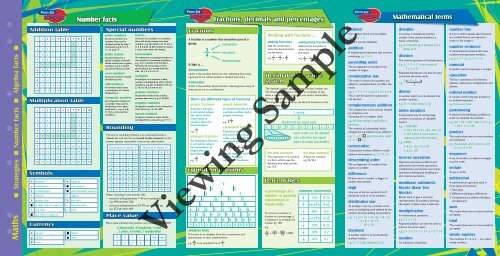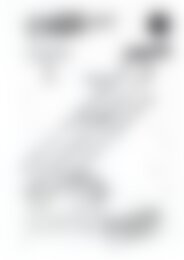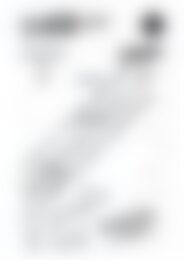PR-6816IRE Essential Study Guides - Number Algebra Strategies
Create successful ePaper yourself
Turn your PDF publications into a flip-book with our unique Google optimized e-Paper software.
<strong>Number</strong> facts <strong>Algebra</strong> facts<br />
<strong>Strategies</strong><br />
Maths<br />
Addition table<br />
+ 1 2 3 4 5 6 7 8 9 10<br />
1 2 3 4 5 6 7 8 9 10 11<br />
2 3 4 5 6 7 8 9 10 11 12<br />
3 4 5 6 7 8 9 10 11 12 13<br />
4 5 6 7 8 9 10 11 12 13 14<br />
5 6 7 8 9 10 11 12 13 14 15<br />
6 7 8 9 10 11 12 13 14 15 16<br />
7 8 9 10 11 12 13 14 15 16 17<br />
8 9 10 11 12 13 14 15 16 17 18<br />
9 10 11 12 13 14 15 16 17 18 19<br />
10 11 12 13 14 15 16 17 18 19 20<br />
Multiplication table<br />
x 1 2 3 4 5 6 7 8 9 10<br />
1 1 2 3 4 5 6 7 8 9 10<br />
2 2 4 6 8 10 12 14 16 18 20<br />
3 3 6 9 12 15 18 21 24 27 30<br />
4 4 8 12 16 20 24 28 32 36 40<br />
5 5 10 15 20 25 30 35 40 45 50<br />
6 6 12 18 24 30 36 42 48 54 60<br />
7 7 14 21 28 35 42 49 56 63 70<br />
8 8 16 24 32 40 48 56 64 72 80<br />
9 9 18 27 36 45 54 63 72 81 90<br />
10 10 20 30 40 50 60 70 80 90 100<br />
Symbols<br />
+ addition<br />
– subtraction<br />
x<br />
multiplication<br />
÷ division<br />
> greater than<br />
greater than or equal to<br />
< less than<br />
less than or equal to<br />
Currency<br />
£ pound<br />
p pence<br />
€ euro<br />
www .prim-ed.com<br />
= equal to<br />
not equal to<br />
approximately equal to<br />
° degree<br />
% per cent<br />
. decimal point<br />
: ratio<br />
$ dollar<br />
c cent<br />
<strong>Number</strong> facts<br />
Special numbers<br />
prime numbers<br />
A prime number is a<br />
number that can be<br />
divided evenly by only 1<br />
and itself; e.g. 2, 3, 5, 7,<br />
11, 13 and 17.<br />
prime factors<br />
A prime factor is a<br />
prime number that will<br />
divide evenly into a given<br />
number; e.g. 2, 3 and 5<br />
are prime factors of 30.<br />
even numbers<br />
A whole number exactly<br />
divisible by two.<br />
odd numbers<br />
A number that leaves<br />
a remainder of 1 when<br />
divided by 2.<br />
composite numbers<br />
A composite number is<br />
a number that can be<br />
divided by more than<br />
itself and 1; e.g. 4, 6, 8,<br />
9, 12 (i.e. not a prime<br />
number).<br />
Rounding<br />
factors<br />
A factor of a number is a number<br />
that will divide evenly into that<br />
number; e.g. the factors of 12 are 1,<br />
2, 3, 4, 6 and 12. All numbers except<br />
1 have more than one factor.<br />
factorisation<br />
To represent a counting number as<br />
the product of counting numbers;<br />
e.g. 24 = 4 x 6; 8 x 3; 12 x 2; 24 x 1<br />
To show 24 as a product of its<br />
prime factors, it would look like<br />
this: 24 = 2 x 2 x 2 x 3<br />
multiples<br />
A multiple of a number is that<br />
number multiplied by other whole<br />
numbers; e.g. the multiples of 5 are<br />
5, 10, 15, 20, 25 and so on.<br />
positive numbers<br />
A positive number has a value<br />
greater than zero; e.g. 4, 25, 699<br />
negative numbers<br />
A negative number has a value less<br />
than zero; e.g. -4, -25, -699<br />
square numbers<br />
A square number’s units can be<br />
arranged into a square; e.g. 2 2 = 4 : :<br />
The key to rounding numbers is to understand what is<br />
‘closer to’ and use this to ‘round to the nearest’ so the<br />
answer appears reasonable. Look at the chart below.<br />
Round down to nearest 10 Round up to nearest 10<br />
0 1 2 3 4 5 6 7 8 9<br />
10 11 12 13 14 15 16 17 18 19<br />
20 21 22 23 24 25 26 27 28 29<br />
30 31 32 33 34 35 36 37 38 39<br />
40 41 42 43 44 45 46 47 48 49<br />
50 51 52 53 54 55 56 57 58 59<br />
60 61 62 63 64 65 66 67 68 69<br />
70 71 72 73 74 75 76 77 78 79<br />
80 81 82 83 84 85 86 87 88 89<br />
90 91 92 93 94 95 96 97 98 99<br />
When rounding to the nearest 100:<br />
• amounts ending between 1–49 are rounded down;<br />
e.g. 348 becomes 300<br />
• amounts ending between 50–99 are rounded up;<br />
e.g. 353 becomes 400<br />
Place value<br />
Place value indicates the position of a numeral; e.g. 4032.87<br />
4 thousands, 0 hundreds, 3 tens,<br />
2 units, 8 tenths, 7 hundredths<br />
Th H T U • Tths Hths<br />
4 0 3 2 • 8 7<br />
www .prim-ed.com<br />
Fractions<br />
3<br />
4<br />
Fractions, decimals and percentages<br />
A fraction is a number that describes part of a<br />
group.<br />
numerator<br />
vinculum<br />
denominator<br />
It has a …<br />
denominator<br />
which is the number below the line, indicating how many<br />
equal parts the whole number is divided into; and a …<br />
numerator<br />
which is the number above the line, indicating how many of<br />
these parts are in consideration.<br />
There are different types of fractions …<br />
proper fractions mixed numerals<br />
A proper fraction A mixed numeral is both<br />
is a fraction where a whole number and a<br />
the value of the proper fraction;<br />
numerator is<br />
smaller than the e.g. 1 1 2<br />
denominator;<br />
e.g. 1 equivalent fractions<br />
2<br />
Fractions that name<br />
the same numerical<br />
improper fractions<br />
value even though the<br />
An improper fraction numerals are different;<br />
is a fraction where<br />
the numerator is<br />
1 2 3 4<br />
e.g. 2 , 4 , 6 , 8<br />
larger than the<br />
denominator;<br />
are all equal to each<br />
4<br />
other. They are<br />
e.g. 3<br />
equivalent fractions.<br />
Equivalent fractions<br />
simplest form<br />
A fraction in its simplest form has a numerator and<br />
denominator in their smallest form;<br />
4<br />
e.g.<br />
8 in its simplest form is 1 2<br />
Working with fractions …<br />
adding fractions<br />
Add the numerators<br />
when the denominators<br />
are the same;<br />
e.g. 1 4 + 2 4 = 3 4<br />
Decimal place value<br />
system<br />
The decimal number system is based on the number ten.<br />
The decimal place system is based on multiples of ten,<br />
when a whole number is divided into tenths, hundredths,<br />
thousandths, and so on.<br />
This diagram shows how we use decimal fractions or the<br />
decimal place system.<br />
1 whole<br />
divided into ten equal parts<br />
0.1 0.1 0.1 0.1 0.1 0.1 0.1 0.1 0.1 0.1<br />
decimal notation<br />
The expression of a numeral<br />
in a form which uses the<br />
decimal place value system;<br />
e.g. 13.5<br />
Percentages<br />
A percentage is a<br />
number or quantity<br />
represented in<br />
hundredths.<br />
To convert a number or<br />
fraction to a percentage, it<br />
is necessary to multiply the<br />
number by 100;<br />
e.g.<br />
8<br />
10 x 100<br />
1 = 800<br />
10 = 80%<br />
subtracting fractions<br />
Subtract the numerators<br />
when the denominators are<br />
the same;<br />
e.g. 3<br />
4 – 1 4 = 2 4<br />
each tenth can be divided<br />
into a further ten equal<br />
parts to make hundredths<br />
decimal numeral<br />
A base ten numeral;<br />
e.g. 36, 96.1<br />
common conversions<br />
3<br />
4 75% 0.75<br />
2<br />
3 66.66% 0.66<br />
Viewing Sample<br />
1<br />
2 50% 0.5<br />
1<br />
3 33.33% 0.33<br />
1<br />
4 25% 0.25<br />
1<br />
5 20% 0.2<br />
1<br />
10 10% 0.1<br />
www .prim-ed.com<br />
addend<br />
Any number which is to be added;<br />
e.g. 2 + 5 = 7<br />
(2 and 5 are the addends).<br />
addition<br />
A mathematical operation that involves<br />
combining; e.g. 3 + 4<br />
ascending order<br />
The arrangement of numbers from<br />
smallest to largest.<br />
commutative law<br />
The order in which two numbers are<br />
added or multiplied does not affect the<br />
result;<br />
e.g. 3 + 7 = 7 + 3 and 4 x 6 = 6 x 4<br />
This is not the same for subtraction<br />
and division.<br />
complementary addition<br />
The complement is the amount needed<br />
to complete a set.<br />
‘Counting on’ to a higher total;<br />
e.g. the way change is paid after a<br />
purchase.<br />
The method of ‘subtracting’ which<br />
changes the subtraction to an addition;<br />
e.g. 7 – 3 = gives the same result<br />
as 3 + = 7<br />
consecutive<br />
Consecutive numbers follow in order<br />
without interruption; e.g. 11, 12, 13.<br />
descending order<br />
The arrangement of numbers from<br />
largest to smallest.<br />
difference<br />
By how much a number is bigger or<br />
smaller than another.<br />
digit<br />
Any one of the ten symbols 0 to 9<br />
(inclusive) used to write numbers.<br />
distributive law<br />
To multiply a sum by a number is the<br />
same as multiplying each addend by the<br />
number and then adding the products;<br />
e.g. 3 x (4 + 2) = (3 x 4) + (3 x 2)<br />
3 x 6 = 12 + 6<br />
18 = 18<br />
dividend<br />
A number which is to be divided by<br />
another number;<br />
e.g. 21 ÷ 3 (the dividend is 21).<br />
Mathematical terms<br />
divisible<br />
A number is divisible by another<br />
number if the second number is a<br />
factor of the fi rst;<br />
e.g. 6 is divisible by 2 because 2 is a<br />
factor of 6.<br />
division<br />
The inverse operation of multiplication;<br />
e.g. 21 ÷ 7 = 3 is the inverse of<br />
7 x 3 = 21<br />
Repeated subtraction can also be used<br />
to achieve the same result.<br />
21 – 7 – 7 – 7<br />
e.g.<br />
3<br />
divisor<br />
A number which is to be divided into<br />
another number;<br />
e.g. 21 ÷ 3 (the divisor is 3).<br />
index notation<br />
A shortened way of writing large<br />
numbers as products of repeated<br />
factors;<br />
e.g. 1 000 000<br />
= 10 x 10 x 10 x 10 x 10 x 10<br />
= 10 6 where 6 is the index or<br />
exponent and 10 is the base.<br />
e.g. 6200<br />
= 6.2 x 10 x 10 x 10<br />
= 6.2 x 10 3<br />
inverse operation<br />
Opposite operations; addition and<br />
subtraction are inverse operations;<br />
multiplication and division are inverse<br />
operations; halving and doubling are<br />
also inverse operations.<br />
multibase arithmetic<br />
blocks (Base Ten<br />
blocks)<br />
Blocks used to give a concrete<br />
representation of numbers, showing<br />
the aspect of place value in base ten.<br />
multiplication<br />
A mathematical operation;<br />
e.g. 7 x 2 = 14<br />
Repeated addition can also be used to<br />
achieve the same result;<br />
e.g. 2 + 2 + 2 + 2 + 2 + 2 + 2 = 14<br />
number<br />
An indication of quantity.<br />
number line<br />
A line on which equally spaced points<br />
are marked. Points correspond, in<br />
order, to the integers.<br />
number sentence<br />
A mathematical sentence that uses<br />
numbers and operation symbols;<br />
e.g. 6 + 7 = 13; 6 + 7 > 10<br />
numeral<br />
A symbol used to represent a number.<br />
operation<br />
The four operations of arithmetic:<br />
addition, subtraction, multiplication and<br />
division.<br />
ordinal number<br />
A number which indicates position in<br />
an ordered sequence;<br />
e.g. fi rst, second, third.<br />
partitioning<br />
A method of simplifying a problem in<br />
order to calculate the solution;<br />
e.g. 47 + 54 = (40 + 50) + (7 + 4)<br />
= 90 + 11 = 101<br />
product<br />
The result when two or more numbers<br />
are multiplied;<br />
e.g. the product of 2, 3 and 4 is 24,<br />
2 x 3 x 4 = 24<br />
sequence<br />
A set of numbers or objects arranged<br />
in some order.<br />
seriate<br />
To put in order.<br />
subtraction<br />
A mathematical operation used in<br />
three types of situations:<br />
1. Take away<br />
2. Difference (fi nding a difference)<br />
3. Complementary addition (fi nding a<br />
complement).<br />
sum<br />
The result when two or more numbers<br />
are added.<br />
total<br />
The result when two or more numbers<br />
are added.<br />
whole number<br />
The numbers 0, 1, 2, 3, 4 … are called<br />
whole numbers.<br />
6816RE maths 1.indd 1<br />
8/12/05 11:00:56 AM
www .prim-ed.com<br />
Order of operation<br />
This is a rule for performing<br />
operations in expressions<br />
which have more than<br />
one operation, to ensure<br />
calculations are handled in<br />
the same way.<br />
Some calculators use an<br />
‘algebraic operating system’<br />
(AOS). This is used to follow<br />
the Rule of Order.<br />
Note:<br />
Multiplication and division are equally powerful operations,<br />
completed left to right in order as they appear, as are<br />
addition and subtraction.<br />
Patterns<br />
Patterns are repeated designs. Patterns occur in<br />
mathematics in many different ways and always follow a rule.<br />
Simple number patterns such as odd and even numbers are<br />
easily identifi ed. Here are some more complex patterns.<br />
Triangular numbers<br />
A triangular number is a number that can form the shape of a<br />
triangle.<br />
1 3 6 10<br />
May also be shown as<br />
Square numbers<br />
A square number is a number that can form the shape of a<br />
square.<br />
1 4<br />
9<br />
16<br />
Word problems as equations<br />
Sequences<br />
A sequence is a list of items. Any item in the list can be<br />
named by its position: first, second, third, fourth and so on.<br />
Some lists have patterns which define the position of each<br />
item. There are two kinds of sequences:<br />
Mathematical terms<br />
A word problem needs to be changed into an equation before it can be solved. ‘Key words’ and phrases are used in word<br />
problems to tell what type of operation (addition, subtraction, multiplication, division) should be used to solve the problem.<br />
Look at the<br />
table. It shows<br />
some common<br />
key words and<br />
phrases, together<br />
with the correct<br />
operation needed<br />
to solve the<br />
problem.<br />
Brackets ( )<br />
Index notation 2 3<br />
Multiplication x<br />
Division ÷<br />
Addition +<br />
Subtraction –<br />
Operation Key word Word problem Equation<br />
addition<br />
subtraction<br />
multiplication<br />
division<br />
<strong>Algebra</strong> facts<br />
sum The sum of my age and 15 equals 32. a + 15 = 32<br />
total<br />
The total of my age and my brother’s age, who is 11<br />
years old, is 24.<br />
a + 11 = 24<br />
more than<br />
Fifteen more than my age equals 32.<br />
(Can also be subtraction.)<br />
a + 15 = 32<br />
difference<br />
The difference between my age and my younger<br />
sister’s age, who is 9 years old, is 3 years.<br />
a – 9 = 3<br />
less than Twelve less than my age equals 49. a – 12 = 49<br />
product The product of my age and 21 is 252. a x 21 = 252<br />
times Five times my age is 60. 5 x a = 60<br />
group A number grouped into lots of 6 is 5. a ÷ 6 = 5<br />
shared<br />
equally<br />
A ‘finite’ sequence is a list made up of<br />
a limited number of items.<br />
For example,<br />
9, 0, 9, 0, 9, 0, 9, 0, 9, 0, 9, 0 is the sequence of 6<br />
alternating 9s and 0s.<br />
1, 3, 5, 7, 9, 11, 13, 15, 17, 19 is the sequence of the<br />
fi rst 10 odd numbers.<br />
An ‘infinite’ sequence is a list that<br />
continues without end.<br />
For example,<br />
d, e, f, d, e, f, d, e, f, d, e ... is the sequence of the<br />
letters d, e, f, repeating in this pattern forever.<br />
2, 4, 6, 8, 10, 12, 14, 16 ... is the sequence of even<br />
whole numbers. The 50th number in this sequence<br />
is 100.<br />
constant<br />
Adding, subtracting,<br />
multiplying or dividing by the<br />
same amount each time.<br />
equivalent<br />
Having the same value.<br />
equation<br />
A statement of equality<br />
between two expressions;<br />
e.g. 3 x 4 = 6 + 6<br />
132 lollies shared equally among a number of<br />
children is 11 lollies each.<br />
growing<br />
A pattern that is becoming<br />
larger.<br />
inequality<br />
Not having the same value.<br />
repeating<br />
The pattern uses the same<br />
symbols or pictures over<br />
and over.<br />
e.g. 3, 4, 3, 4, 3 …<br />
132 ÷ a = 11<br />
To make mental maths easier, use your known number facts first. Here are some<br />
ideas to help you …<br />
Counting on<br />
3 + 5 =<br />
(change the order) 5 + 3 =<br />
1 2 3<br />
5 6 7 8<br />
6 + 11 =<br />
(change the order) 11 + 6 =<br />
1 2 3 4 5 6<br />
11 12 13<br />
Doubling<br />
3 + 3 = 6<br />
5 + 5 = 10<br />
13 + 13 = 26<br />
Ask<br />
clarifying<br />
questions<br />
What is the<br />
question<br />
asking?<br />
Do I know<br />
anything about<br />
this topic?<br />
What does …<br />
really mean?<br />
What else<br />
could I find out<br />
about to help<br />
me answer the<br />
question?<br />
14 15 16 17<br />
Make<br />
assumptions<br />
Using my<br />
knowledge<br />
of … I can<br />
assume …<br />
I think …<br />
because I<br />
know …<br />
If I know …<br />
then it could<br />
be …<br />
Mental strategies<br />
25 + 25 = 50<br />
33 + 33 = 66<br />
70 + 70 = 140<br />
Estimate<br />
Can I use my<br />
judgment<br />
to make<br />
a suitable<br />
guess?<br />
What<br />
strategies<br />
could I use<br />
to estimate<br />
a solution to<br />
the problem?<br />
Near doubles<br />
5 + 6 =<br />
(5 + 5) + 1 =<br />
10 + 1 = 11<br />
Survey<br />
Can I find out<br />
information<br />
by asking a<br />
sample of<br />
people?<br />
Do I need to<br />
investigate<br />
similar data<br />
and compare<br />
it to my<br />
information?<br />
OR<br />
Bridging a ten<br />
Example 1<br />
9 + 6 =<br />
(9 + 1) + 5 =<br />
10 + 5 = 15<br />
Partitioning<br />
5 + 8 =<br />
(5 + 5) + 3 =<br />
10 + 3 = 13<br />
Problem-solving strategies<br />
Locate<br />
information<br />
Where<br />
could I find<br />
information to<br />
help me solve<br />
the problem?<br />
Internet<br />
Library<br />
Things I<br />
already know<br />
Ask an expert<br />
Friends<br />
Adults<br />
5 + 6 =<br />
(6 + 6) – 1 =<br />
12 – 1 = 11<br />
Example 2<br />
www .prim-ed.com<br />
7 + 5 =<br />
(7 + 3) + 2 =<br />
10 + 2 = 12<br />
Present<br />
findings<br />
What is the<br />
best way to<br />
show what I<br />
have found?<br />
Diagrams<br />
Tables<br />
Graphs<br />
Calculations<br />
Explanations<br />
It is important to check your work to make sure answers to problems are<br />
correct and sensible. Checking your work can be done in many ways; some<br />
are shown below.<br />
Question your<br />
answer<br />
Ask yourself if the answer sounds<br />
right. A question you might ask<br />
yourself is …<br />
‘Is the answer way too big or way<br />
too small?’<br />
If you think the answer does<br />
not seem right, try some of the<br />
following checking strategies.<br />
Addition Subtraction Multiplication<br />
odd + odd = even<br />
odd + even = odd<br />
even + even = even<br />
Consider the size of the answer …<br />
When you read a question, do you ever consider how big the answer will be? Think<br />
about if the answer will be in tens, hundreds, thousands … or bigger! There is a<br />
pattern that can help alert you to potential errors.<br />
Addition<br />
Multiplication<br />
<strong>Number</strong> of digits<br />
Answer likely to be in the …<br />
1 digit + 1 digit units or tens<br />
2 digits + 1 digit tens or hundreds<br />
2 digits + 2 digits tens or hundreds<br />
3 digits + 1 digit hundreds or thousands<br />
3 digits + 2 digits hundreds or thousands<br />
3 digits + 3 digits hundreds or thousands<br />
1 digit x 1 digit units or tens<br />
2 digits x 1 digit tens or hundreds<br />
2 digits x 2 digits hundreds or thousands<br />
3 digits x 1 digit hundreds or thousands<br />
3 digits x 2 digits thousands or ten thousands<br />
3 digits x 3 digits ten thousands or hundred thousands<br />
Estimating<br />
Estimating gives you an answer that is<br />
close to the exact answer. It is usually<br />
found by rounding or by using judgment<br />
to make a ‘best guess’.<br />
Front-end rounding<br />
1. Look at the left-most digit in the<br />
number.<br />
2. Consider the place value of the digit.<br />
For example,<br />
3 2 1 5<br />
6 9 1 0<br />
+ 4 3 4 2<br />
3 + 6 + 4 = 13<br />
Viewing Sample<br />
www .prim-ed.com<br />
So the estimate would be 13 000.<br />
Checking strategies<br />
Odd and even numbers<br />
Odd and even numbers follow a pattern. Once you are aware of the pattern, all<br />
you need to do is look at the units digits of the numbers in the problem, and the<br />
answer to determine whether the answer is defi nitely wrong or possibly correct.<br />
Think about the context of the<br />
numbers before rounding.<br />
For example,<br />
When calculating the cost of groceries,<br />
it is probably better to overestimate so<br />
you do not run short of money.<br />
When calculating, you<br />
should:<br />
1. Estimate<br />
2. Calculate<br />
3. Evaluate (How close was your<br />
estimate? Could you improve on<br />
your technique?)<br />
odd – odd = even<br />
odd – even = odd<br />
even – odd = odd<br />
even – even = even<br />
odd x odd = odd<br />
odd x even = even<br />
even x even = even<br />
Divisibility<br />
rules<br />
It is often helpful to know when one<br />
number may be divided into another<br />
without leaving a remainder.<br />
2<br />
3<br />
4<br />
5<br />
6<br />
9<br />
10<br />
11<br />
12<br />
25<br />
100<br />
Any even number;<br />
e.g. 2, 4, 6, 8 or 0<br />
Sum of all digits = multiple of 3;<br />
e.g. 8652 = 8 + 6 + 5 + 2 = 21;<br />
2 + 1 = 3<br />
Last two digits divisible by 4;<br />
e.g. 23 632, 45 656, 13 988<br />
Any number ending in 0 or 5;<br />
e.g. 20, 45, 670, 9845<br />
Any number divisible by 2 and 3;<br />
e.g. 54, 972, 2196<br />
Sum of all digits = multiple of 9;<br />
e.g. 72 567 = 7 + 2 + 5 + 6 + 7<br />
= 27; 2 + 7 = 9<br />
Any number ending in 0;<br />
e.g. 10, 200, 7680, 98 450<br />
Alternate digit sums differ by a<br />
multiple of 11 or 0;<br />
e.g. 76 285 = 7 + 2 + 5 = 14<br />
6 + 8 = 14; 14 – 14 = 0<br />
Any number divisible by 3 and 4;<br />
e.g. 180, 720, 3600<br />
Last two digits divisible by 25;<br />
e.g. 6475, 8950<br />
Last two digits are 00;<br />
e.g. 67 400, 589 780 300<br />
Repeat the calculation:<br />
•<br />
carefully, in exactly the same<br />
way.<br />
• using the inverse operation.<br />
• using a different method.<br />
Maths<br />
No part of this publication may be reproduced in any form or<br />
by any means, electronic or mechanical, including photocopying<br />
or recording, or by any information storage and retrieval<br />
system, without written permission from the publisher.<br />
<strong>PR</strong>–6816<br />
Copyright Information<br />
ISBN 1-84654-025-9<br />
9!BMFCIA:TSOQTV!<br />
6816RE maths 1.indd 2<br />
8/12/05 11:01:07 AM

















